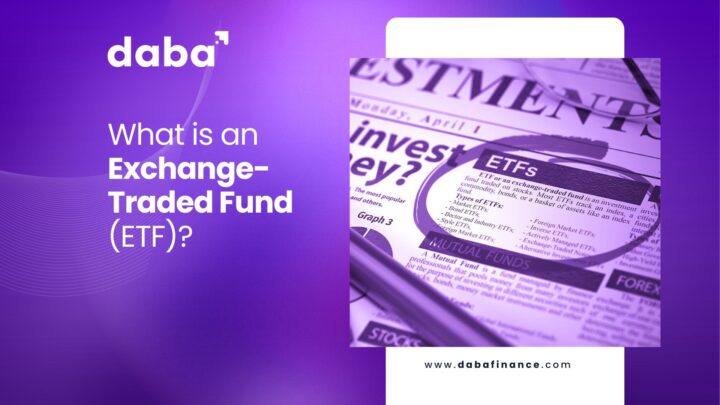What is an Exchange-Traded Fund (ETF)?
8 min Read June 27, 2024 at 9:47 AM UTC

An Exchange-Traded Fund, commonly known as an ETF, is a type of investment fund traded on stock exchanges, much like individual stocks.
In recent years, the African financial landscape has been evolving rapidly, with new investment opportunities emerging for individual and institutional investors.
One such investment vehicle that has gained popularity globally and is now making its way into African markets is the Exchange-Traded Fund (ETF). We explore what ETFs are, how they work, and their potential benefits for African investors.
What are ETFs?
An Exchange-Traded Fund, commonly known as an ETF, is a type of investment fund traded on stock exchanges, much like individual stocks.
ETFs are designed to track the performance of a specific index, sector, commodity, or other asset. They offer investors a way to gain exposure to a diverse range of securities through a single investment vehicle.
How ETFs Work
Structure and Creation: ETFs are created by financial institutions that select a basket of securities to represent a particular market segment or investment strategy. These securities are then bundled together to form the ETF. The fund issues shares that represent ownership in this basket of assets.
Trading on Exchanges: Unlike traditional mutual funds, ETFs can be bought and sold throughout the trading day on stock exchanges. This feature provides investors with greater flexibility and liquidity compared to mutual funds, which are typically priced and traded only once per day.
Tracking Mechanism: ETFs are designed to closely follow the performance of their underlying assets or indices. Fund managers use various techniques to ensure that the ETF’s performance aligns with its benchmark, including full replication (holding all securities in the index) or sampling (holding a representative selection of securities).
Types of ETFs Available in African Markets
While the ETF market in Africa is still developing, there are several types of ETFs that investors can consider:
Equity ETFs: These track stock market indices, such as the iShares MSCI South Africa ETF or the VanEck Africa Index ETF.
Bond ETFs: These invest in fixed-income securities, providing exposure to government or corporate bonds.
Commodity ETFs: These track the price of commodities like gold, oil, or agricultural products, which are particularly relevant to many African economies.
Currency ETFs: These allow investors to gain exposure to foreign currencies or baskets of currencies.
Sector-specific ETFs: These focus on particular industries or sectors, such as mining, telecommunications, or financial services.
Benefits of ETFs for African Investors
Diversification: ETFs offer instant diversification by providing exposure to a broad range of securities within a single investment. This is particularly beneficial for African investors who may have limited access to diverse investment options.
Lower Costs: Compared to actively managed funds, ETFs generally have lower expense ratios due to their passive management style. This can result in significant cost savings for investors over time.
Transparency: ETFs typically disclose their holdings daily, allowing investors to see exactly what they own. This transparency is valuable in markets where information may be less readily available.
Accessibility: ETFs provide African investors with access to markets and asset classes that might otherwise be difficult or expensive to invest in directly, such as international stocks or commodities.
Flexibility: The ability to trade ETFs throughout the day on stock exchanges offers investors greater control over their investment timing and strategy.
Challenges and Considerations for ETF Investing in Africa
Limited Selection: While growing, the range of ETFs available in African markets is still relatively limited compared to more developed markets. This may restrict investment options for local investors.
Liquidity Concerns: Some ETFs in African markets may have lower trading volumes, which could impact liquidity and the ability to buy or sell shares at desired prices.
Regulatory Environment: The regulatory framework for ETFs varies across African countries, and investors should be aware of the specific regulations governing ETF investments in their jurisdiction.
Currency Risk: For ETFs that invest in international assets, currency fluctuations can impact returns, particularly given the volatility of some African currencies.
Market Infrastructure: The development of efficient market infrastructure, including reliable trading platforms and clearing systems, is crucial for the growth of the ETF market in Africa.
Key Terms to Know Before Investing in ETFs
- Assets Under Management (AUM): The total market value of all assets held by an ETF. It indicates the size and popularity of the fund. Generally, higher AUM suggests better liquidity and lower costs.
- Expense Ratio: The annual fee charged by the ETF to cover operating expenses. It’s expressed as a percentage of the fund’s average net assets. Lower expense ratios mean more of the returns go to investors.
- Net Asset Value (NAV): The per-share value of an ETF’s underlying assets minus liabilities. It’s calculated at the end of each trading day and is used to determine if an ETF is trading at a premium or discount.
- Tracking Error: The difference between an ETF’s performance and its benchmark index. Lower tracking error indicates the ETF is closely following its index. It can be caused by fees, trading costs, or sampling techniques.
- Bid-Ask Spread: The difference between the highest price a buyer will pay (bid) and the lowest price a seller will accept (ask). Narrower spreads indicate better liquidity and lower trading costs. It’s important for short-term traders and those making large transactions.
- Creation/Redemption Units: Large blocks of ETF shares (typically 50,000 or more) that can be created or redeemed with the fund company. This process helps keep the ETF’s market price close to its NAV and is usually handled by authorized participants.
- Distribution Yield: The annual yield an investor would receive if the most recent distribution stayed constant. It’s calculated by annualizing the most recent distribution and dividing by the NAV. This is important for income-focused investors.
- Total Return: The overall return of an ETF, including price appreciation and distributions. It’s usually expressed as a percentage over a specific period and provides a comprehensive view of the ETF’s performance.
- Liquidity: The ease with which an ETF can be bought or sold without significantly impacting its price. Generally, ETFs with higher trading volumes are more liquid. This is important for investors who may need to exit positions quickly.
- Rebalancing: The process of adjusting an ETF’s holdings to maintain its target allocation or track its index. It can occur daily, quarterly, or annually depending on the ETF, and may impact the fund’s tracking error and tax efficiency.
- Premium/Discount: The difference between an ETF’s market price and its NAV. A premium means the ETF is trading above its NAV; a discount means it’s trading below. Large or persistent premiums/discounts may indicate inefficiencies in the ETF’s structure.
- Index Weighting: The method used to determine how much of each security is held in the index (and consequently the ETF). Common methods include market-cap weighting, equal weighting, and factor-based weighting. This affects the ETF’s exposure to different companies and sectors.
- Securities Lending: The practice of loaning out securities held by the ETF to generate additional income. It can help offset expenses and improve returns but carries some counterparty risk, which is typically managed by the fund.
- Authorized Participant (AP): Large financial institutions that create and redeem ETF shares. They play a crucial role in maintaining the ETF’s liquidity and keeping its price close to NAV. APs work directly with the ETF provider in the primary market.
- Primary Market: Where creation and redemption of ETF shares occur between the fund and authorized participants. This helps maintain the ETF’s liquidity and price efficiency. The primary market is not directly accessible to retail investors.
- Secondary Market: Where most ETF trading occurs, typically on stock exchanges. This is where retail investors buy and sell ETF shares. Prices in the secondary market are determined by supply and demand.
Understanding these terms can help investors better evaluate and compare different ETFs, assess their costs and risks, and make more informed investment decisions.
How to Invest in ETFs
Research and Selection: Investors should carefully research available ETFs, considering factors such as the underlying index or assets, expense ratio, tracking error, and trading volume.
Digital Investment Platforms: Utilizing digital investment platforms like Daba can simplify the process of researching and investing in ETFs. For instance, Daba provides access to various ETFs, including those offered on the BRVM (Bourse Régionale des Valeurs Mobilières), facilitating investments in West African markets.
Brokerage Account: To invest in ETFs, individuals typically need to open a brokerage account with a local or international broker that provides access to the relevant stock exchanges.
Investment Strategy: Investors should develop a clear investment strategy, considering their financial goals, risk tolerance, and investment horizon when selecting ETFs.
Regular Monitoring: While ETFs are generally passive investments, it’s important to periodically review and rebalance your portfolio to ensure it remains aligned with your investment objectives.
Conclusion
Exchange-traded funds represent an exciting development in the African investment landscape, offering investors a flexible, cost-effective way to diversify their portfolios and access a wide range of markets.
As the ETF market in Africa continues to grow and mature, it has the potential to play a significant role in deepening capital markets and providing new opportunities for both retail and institutional investors.
However, as with any investment, it’s crucial for African investors to thoroughly understand the characteristics, benefits, and risks associated with ETFs before incorporating them into their investment strategies.
By doing so, investors can harness the potential of ETFs to build more robust and diversified portfolios tailored to the unique opportunities and challenges of the African financial markets.
This material has been presented for informational and educational purposes only. The views expressed in the articles above are generalized and may not be appropriate for all investors. The information contained in this article should not be construed as, and may not be used in connection with, an offer to sell, or a solicitation of an offer to buy or hold, an interest in any security or investment product. There is no guarantee that past performance will recur or result in a positive outcome. Carefully consider your financial situation, including investment objective, time horizon, risk tolerance, and fees prior to making any investment decisions. No level of diversification or asset allocation can ensure profits or guarantee against losses. Articles do not reflect the views of DABA ADVISORS LLC and do not provide investment advice to Daba’s clients. Daba is not engaged in rendering tax, legal or accounting advice. Please consult a qualified professional for this type of service.

Next Frontier
Stay up to date on major news and events in African markets. Delivered weekly.
Pulse54
UDeep-dives into what’s old and new in Africa’s investment landscape. Delivered twice monthly.
Events
Sign up to stay informed about our regular webinars, product launches, and exhibitions.

